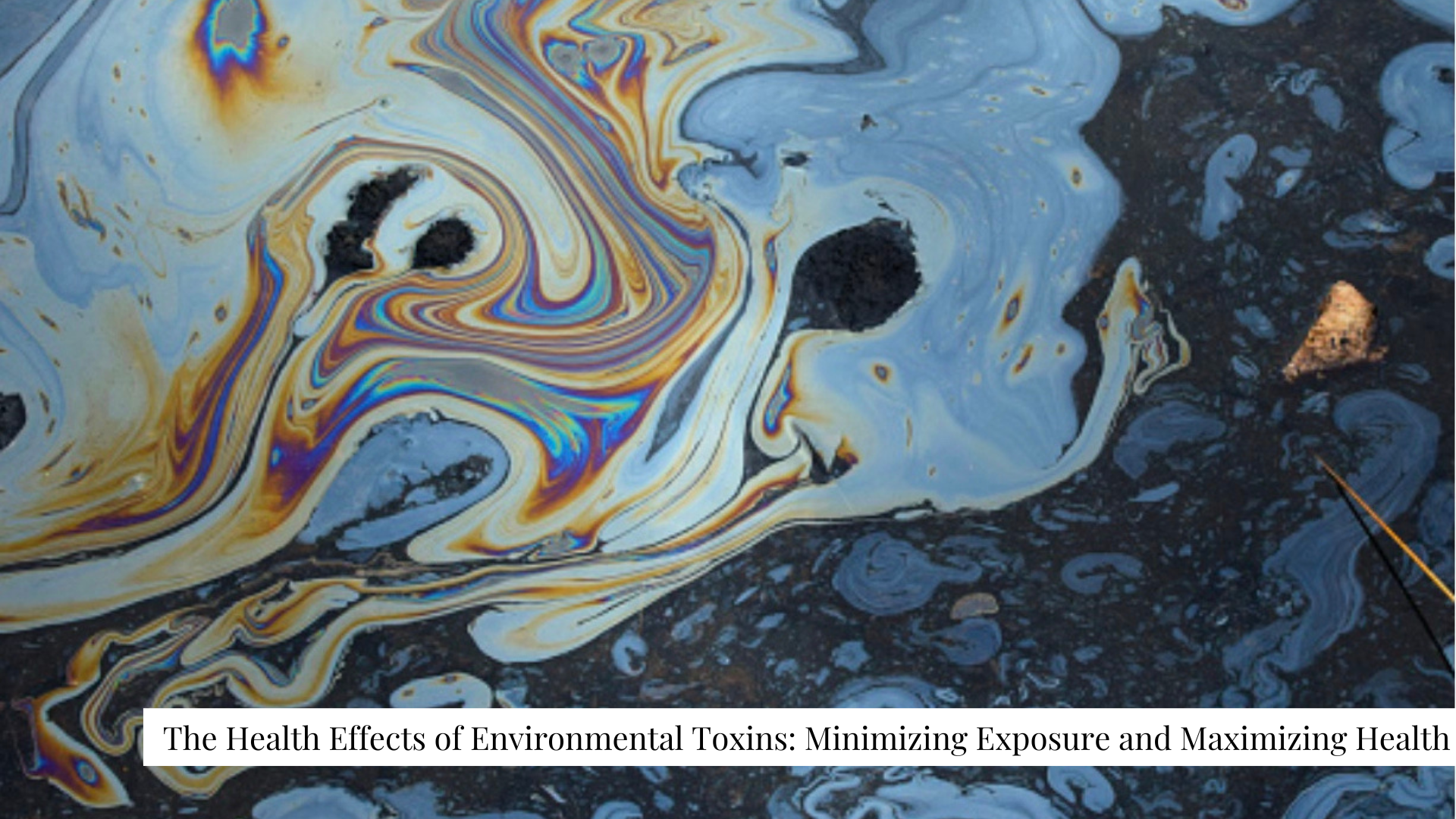 Environmental toxins are all around us, from the air we breathe to the food we eat to the water we drink, and to the products we use. The impact of toxins on our health can be significant and long-lasting, with potentially serious consequences such as cancer, autoimmune diseases, and neurological disorders. In this blog post, I offer you a comprehensive overview of the types of toxins that we may encounter in our environment and offer practical solutions for reducing toxic exposure and protecting our health.
Environmental toxins are all around us, from the air we breathe to the food we eat to the water we drink, and to the products we use. The impact of toxins on our health can be significant and long-lasting, with potentially serious consequences such as cancer, autoimmune diseases, and neurological disorders. In this blog post, I offer you a comprehensive overview of the types of toxins that we may encounter in our environment and offer practical solutions for reducing toxic exposure and protecting our health.
Sources of Toxins
Toxins can come from a variety of sources, including air pollution, water contamination, food toxins, and household and personal care products. Air pollutants such as particulate matter, nitrogen oxides, and ozone can be harmful to human health, as can water contaminants such as heavy metals, pesticides, pharmaceuticals, and radioactive elements. Food toxins such as pesticides, heavy metals, and food additives can accumulate in our bodies over time and are linked to chronic diseases such as cancer — I work with clients who suffer from the impact of these toxins every day. Add to this, household and personal care products, including cleaning products, cosmetics, and fragrances, contain potentially harmful chemicals such as phthalates, parabens, and triclosan.
Types of Toxins
Some of the most common types of toxins that we can encounter in our environment include heavy metals, pesticides and herbicides, plasticizers, and flame retardants. Heavy metals such as lead, mercury, and cadmium are toxic to humans and can be found in contaminated soil, water, and food. Pesticides and herbicides are commonly used in agriculture to control pests and weeds but are harmful to human health and have been linked to a range of health problems, including cancer and neurological disorders (See Footnote (1) below). Plasticizers such as bisphenol A (BPA) and phthalates are used in the production of plastics and can leach into food and beverages. Flame retardants are commonly used in furniture, electronics, and building materials but can be toxic and may accumulate in the body over time.
The Impact of Toxins on Health
Toxins can have a wide range of negative effects on our health, including inflammation and oxidative stress, hormonal disruption, DNA damage and mutations, and cellular dysfunction and death. Inflammation and oxidative stress can lead to tissue damage and chronic diseases such as arthritis, diabetes, and heart disease. Hormonal disruption can cause hormonal imbalances and reproductive problems. DNA damage and mutations can increase the risk of cancer and other diseases, while cellular dysfunction and death can interfere with normal bodily functions. Toxins can also affect the nervous system, leading to neurological problems such as cognitive impairment, memory loss, and Parkinson’s disease.
Reducing Toxic Exposure
Reducing toxic exposure can be challenging but is crucial for protecting our health. Some steps that individuals can take to reduce toxic exposure include choosing organic foods, using natural cleaning products, using air filters and water purifiers (distilled is my recommendation), and avoiding smoking and secondhand smoke. Additionally, reducing exposure to plastics and using safer personal care products can help minimize exposure to harmful chemicals such as phthalates and parabens. Supporting our body’s natural detoxification processes through a whole-foods diet, exercise, and other holistic lifestyle changes can also help reduce the impact of toxins on your health.
In Conclusion
The impact of environmental toxins on our health is significant and multifaceted. Toxins can come from many sources, including air pollution, water contamination, food toxins, and household and personal care products. They can have a wide range of negative effects on our health, including inflammation, hormonal disruption, DNA damage, and neurological problems. Reducing toxic exposure can be challenging but is crucial for protecting our health. By taking steps to reduce exposure to toxins and supporting our body’s natural detoxification processes, we can help minimize the impact of toxins on our health and lead healthier, more vibrant lives.
References For Your Review
There are numerous studies that have linked herbicides and pesticides to cancer and neurological disorders. Here is a recent article published in the Journal of Occupational and Environmental Medicine:
The article titled “Pesticides and Cancer” by Alavanja, M. C. R. (2019) reviews the evidence linking pesticide exposure to cancer. The author notes that numerous studies have found that agricultural workers exposed to pesticides have an increased risk of various types of cancer, including leukemia, lymphoma, brain cancer, and prostate cancer. The author also notes that some pesticides have been classified as carcinogenic by the International Agency for Research on Cancer (IARC).
Similarly, a study published in the journal Environmental Health Perspectives in 2015 found that exposure to certain pesticides was associated with an increased risk of Parkinson’s disease. The study found that individuals who had been exposed to pesticides had a 60% increased risk of developing Parkinson’s disease compared to those who had not been exposed.
Another study published in the journal Neurology in 2011 found that individuals with the highest exposure to pesticides had a 250% increased risk of developing Parkinson’s disease compared to those with the lowest exposure.
Overall, these studies provide strong evidence linking herbicides and pesticides to cancer and neurological disorders. It is important to take steps to minimize exposure to these toxins and protect our health.
Here are some resources you may find helpful in understanding the negative effects of toxins on our health:
- “Toxins and Health” by the National Institute of Environmental Health Sciences: This webpage provides an overview of the different types of toxins and their potential health effects, including inflammation, oxidative stress, and hormonal disruption. It also includes links to additional resources for further reading. Link: https://www.niehs.nih.gov/health/topics/agents/toxins/index.cfm
- “The Toxins That Threaten Our Brains” by The New York Times: This article discusses the impact of toxins on the brain and neurological function, including how exposure to certain chemicals can contribute to neurodegenerative diseases. Link: https://www.nytimes.com/2018/03/13/well/live/the-toxins-that-threaten-our-brains.html
- “Toxic Effects of Chemical Mixtures: The Importance of Synergy” by Environmental Health Perspectives: This article explains how different toxins can interact with each other in ways that increase their toxicity, even at low doses. It also discusses the challenges of studying and regulating exposure to chemical mixtures. Link: https://ehp.niehs.nih.gov/doi/full/10.1289/ehp.1104035
- “The Effects of Toxins on Hormones and Health” by Hormone Health Network: This webpage explains how toxins can disrupt the endocrine system and contribute to a variety of health problems, including reproductive and developmental issues. It also includes tips for reducing exposure to hormone-disrupting chemicals. Link: https://www.hormone.org/your-health-and-hormones/glands-and-hormones-a-to-z/hormones/toxins
- “Air pollution and health” by the World Health Organization (WHO): This report provides a comprehensive overview of the health impacts of air pollution, including particulate matter, nitrogen oxides, and ozone. It discusses the different ways in which air pollution can affect the respiratory, cardiovascular, and nervous systems, as well as the links between air pollution and cancer. Link: https://www.who.int/health-topics/air-pollution#tab=tab_1
- “Human health effects of air pollution” by the National Institute of Environmental Health Sciences: This article summarizes the major health effects of air pollutants, including respiratory and cardiovascular disease, neurological disorders, and developmental problems. It also discusses the ways in which vulnerable populations, such as children and the elderly, may be particularly susceptible to air pollution. Link: https://www.niehs.nih.gov/health/topics/agents/air-pollution/index.cfm
- “Water pollution and human health” by the World Health Organization (WHO): This report discusses the health impacts of various water contaminants, including heavy metals, pesticides, pharmaceuticals, and radioactive elements. It highlights the different ways in which water pollution can affect human health, including through the spread of infectious diseases, exposure to toxic chemicals, and the development of chronic health problems. Link: https://www.who.int/health-topics/water-pollution#tab=tab_1
- “Health risks of heavy metals from long-range transboundary air pollution” by the European Environment Agency: This report focuses specifically on the health risks of heavy metals such as lead, mercury, and cadmium, which can be transported long distances through the air and deposited in soil and water. It discusses the different ways in which heavy metal exposure can affect human health, including through the nervous, immune, and cardiovascular systems. Link: https://www.eea.europa.eu/publications/health-risks-of-heavy-metals
I hope you find this post and these resources helpful!
If you’d like to discuss your health goals and the coaching options I offer, please email me here.





